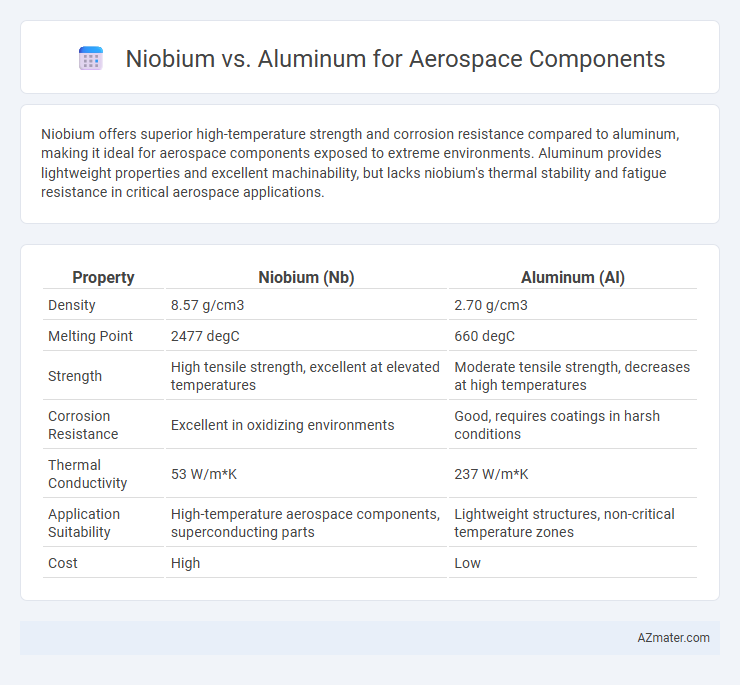Niobium offers superior high-temperature strength and corrosion resistance compared to aluminum, making it ideal for aerospace components exposed to extreme environments. Aluminum provides lightweight properties and excellent machinability, but lacks niobium's thermal stability and fatigue resistance in critical aerospace applications.
Table of Comparison
| Property | Niobium (Nb) | Aluminum (Al) |
|---|---|---|
| Density | 8.57 g/cm3 | 2.70 g/cm3 |
| Melting Point | 2477 degC | 660 degC |
| Strength | High tensile strength, excellent at elevated temperatures | Moderate tensile strength, decreases at high temperatures |
| Corrosion Resistance | Excellent in oxidizing environments | Good, requires coatings in harsh conditions |
| Thermal Conductivity | 53 W/m*K | 237 W/m*K |
| Application Suitability | High-temperature aerospace components, superconducting parts | Lightweight structures, non-critical temperature zones |
| Cost | High | Low |
Introduction to Niobium and Aluminum in Aerospace
Niobium is a refractory metal known for its high melting point, excellent corrosion resistance, and superior strength-to-weight ratio, making it valuable for aerospace components subjected to extreme temperatures and stress. Aluminum, favored for its low density, corrosion resistance, and ease of fabrication, remains a primary material in aerospace structures due to its balance of strength and lightweight properties. Both metals play crucial roles in aerospace engineering, with niobium often used in superalloys and high-performance applications, while aluminum is prevalent in airframe and structural components.
Material Properties Comparison: Niobium vs Aluminum
Niobium exhibits superior high-temperature strength and corrosion resistance compared to aluminum, making it ideal for aerospace components exposed to extreme environments. Aluminum offers lower density and excellent machinability, contributing to reduced weight and cost-effective manufacturing in aerospace applications. While niobium is heavier, its unique ability to maintain structural integrity at temperatures above 1000degC surpasses aluminum's performance limitations around 200degC.
Strength-to-Weight Ratio Analysis
Niobium exhibits a superior strength-to-weight ratio compared to aluminum, making it highly advantageous for aerospace components that require enhanced structural integrity without added mass. Niobium alloys maintain high tensile strength and excellent fatigue resistance at elevated temperatures, critical for turbine blades and jet engine parts where aluminum's performance diminishes. The combination of lightweight properties and robust mechanical strength positions niobium as a premium material choice to improve fuel efficiency and durability in aerospace engineering.
Thermal Resistance and Performance
Niobium exhibits superior thermal resistance compared to aluminum due to its high melting point of 2,468degC, making it ideal for aerospace components exposed to extreme heat. Aluminum, with a melting point of 660degC, offers lightweight properties but significantly lower heat tolerance, limiting its use in high-temperature environments. Aerospace engineers prefer niobium alloys for critical components requiring thermal stability and strength at elevated temperatures, optimizing performance and safety in advanced aerospace applications.
Corrosion Resistance in Aerospace Environments
Niobium exhibits superior corrosion resistance compared to aluminum in aerospace environments, particularly against oxidation and high-temperature degradation. Its ability to form a stable oxide layer enhances durability in harsh atmospheric conditions, making it ideal for components exposed to extreme weather and chemical agents. Aluminum, while lightweight, is more susceptible to pitting and galvanic corrosion, requiring protective coatings for long-term aerospace applications.
Machinability and Fabrication Considerations
Niobium offers superior high-temperature strength and corrosion resistance compared to aluminum, making it ideal for aerospace components exposed to extreme environments. However, aluminum excels in machinability due to its lower hardness and higher thermal conductivity, enabling faster machining processes and reduced tool wear. Fabrication with niobium requires specialized techniques such as vacuum melting and inert atmosphere welding, whereas aluminum benefits from well-established, cost-effective fabrication methods like conventional machining and standard welding practices.
Cost and Availability of Niobium and Aluminum
Niobium offers superior strength-to-weight ratio and high-temperature performance but comes at a significantly higher cost compared to aluminum, which is abundant and cost-effective for large-scale aerospace manufacturing. Aluminum's widespread availability and established supply chains make it the preferred choice for cost-sensitive aerospace components, while niobium's limited production and higher market price restrict its use to specialized applications requiring enhanced material properties. The volatility in niobium prices and concentrated global supply further challenge its adoption despite its performance benefits.
Applications in Aerospace Structures and Components
Niobium exhibits superior high-temperature strength and oxidation resistance compared to aluminum, making it ideal for aerospace turbine blades, rocket nozzles, and structural components exposed to extreme heat. Aluminum offers lightweight properties, excellent corrosion resistance, and high machinability, which are essential for fuselage panels, aircraft frames, and wing assemblies. Both metals are critical in aerospace structures, with niobium preferred for heat-intensive environments and aluminum favored for weight-sensitive, load-bearing applications.
Sustainability and Environmental Impact
Niobium's superior strength-to-weight ratio and corrosion resistance enable lighter, longer-lasting aerospace components, reducing fuel consumption and carbon emissions during operation. Aluminum, while more abundant and easier to recycle, often requires more frequent replacement and higher energy-intensive processing, impacting its overall sustainability footprint. Choosing niobium alloys supports enhanced durability and lifecycle efficiency, aligning with environmental goals in aerospace manufacturing and operation.
Future Trends in Aerospace Material Selection
Niobium is gaining traction in aerospace applications due to its superior high-temperature strength and corrosion resistance compared to aluminum, making it ideal for components exposed to extreme conditions. Emerging additive manufacturing techniques are enabling the precise fabrication of niobium alloys, which enhance performance without significantly increasing weight. Future aerospace material selection increasingly favors niobium for critical engine parts and structural components, driven by demands for higher efficiency, durability, and fuel economy.

Infographic: Niobium vs Aluminum for Aerospace Component
 azmater.com
azmater.com